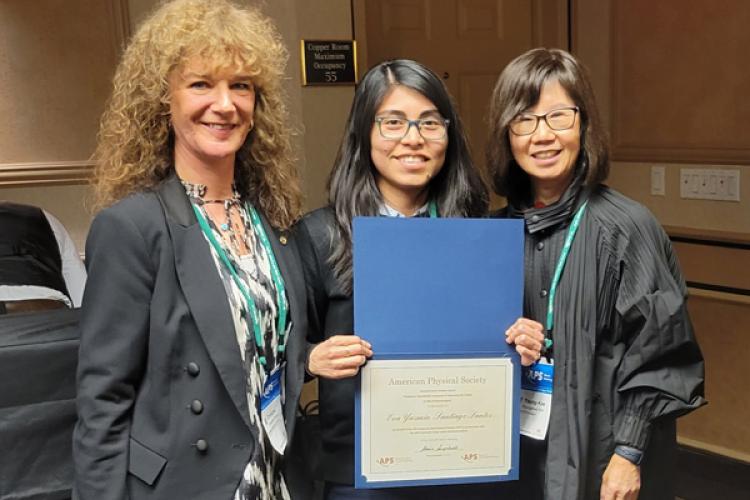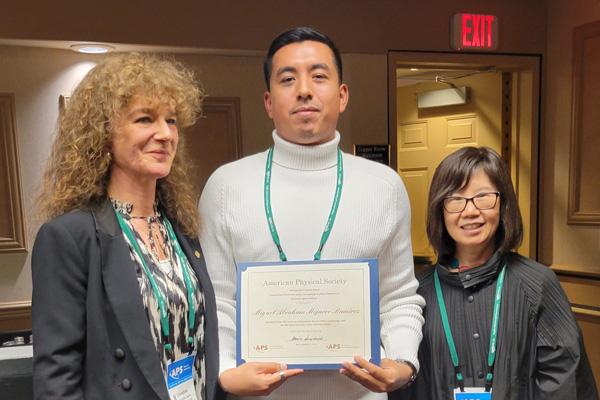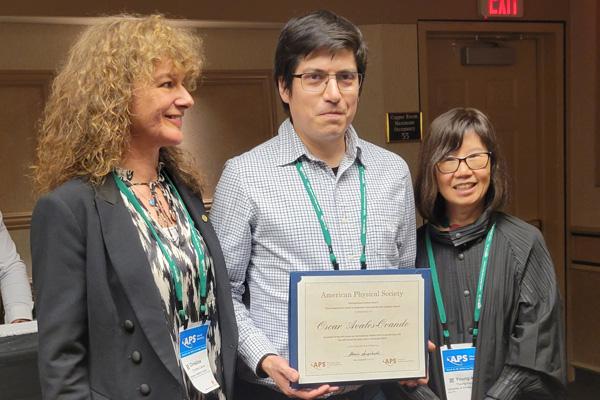
Physics students and alumnus win 5 awards, present their research at American Physical Society meeting

College of Arts and Sciences physics and astronomy students and an alumnus took five major awards as they traveled with Ohio University faculty to the American Physical Society (APS) March meeting in Las Vegas.
The five awards included funds from an APS program that recognizes that bringing outstanding young researchers and early career professions to the annual APS meetings can be a career-changing experience.
The very competitive awards collected by OHIO included three Distinguished Student Awards by graduate students Miguel Mojarro Ramirez and Eva Yazmin Santiago Santos and alumnus Oscar Avalos Ovando.
Mojarro Ramirez also won an Ovshinsky Student Travel Award, and Avalos Ovando, a visiting research scholar and alumnus who earned a Ph.D. in Physics in 2018, won the APS Forum for Early Career Scientists Mini Grant Award.
Physics faculty and students made a total of 12 presentations to the international audience.
"It is very important for our students and postdocs to participate in this conference, by far the largest in physics with 14,000 attendees this year," said Professor of Physics Professor Sergio Ulloa. "Although it is organized by the American Physical Society, its attendees come from all over the world. Our students present their work and progress and establish important research networks which help their career plans and help put their work in perspective in the community."
OHIO presentations at APS
Santiago Santos presented "Plasmonic Nanofluids Composed of Nanorods for Visible to Mid-IR Wavelengths" with Distinguished Professor of Physics Alexander Govorov. Her talk focused on the study of the optical resonances and photochemical activity of plasmonic solutions composed of nanorods (TiN and others), focusing on energy related applications. They discussed how colloidal plasmonic nanomaterials show a strong response to light, which depends on the shape of the nanoparticles, material, and medium. This allows them to tune and extend their spectra from the visible to the mid-infrared ranges.
Avalos Ovando presented on "Two-temperature model in plasmonic nanocrystals with complex shapes" with Govorov. The field of plasmonics has emerged as a novel way of manipulating the optical properties of nanomaterials upon illumination. Firstly, plasmonic nanocrystals (NCs) have shown promising uses, as their optical response can be manipulated through the careful design of their geometry; and secondly, plasmonic NCs generate heat efficiently in the presence of electromagnetic radiation. So, it is natural to wonder what opto-thermal effects occur in plasmonics NCs but with complex shapes.
Avalos Ovando discussed tackling that question by studying the temporal dynamics of several complex-shape gold NCs. "We use a two-temperature model to study the ultrafast photothermal responses, and we solve for the lattice and the electronic temperatures. We observe the creation of local modifications of the dielectric function via the temperature, which leads to the thermal imprint of plasmonic hotspots. Also, absorption signals are largely enhanced at the ultrafast timescales, showing that this is a general effect on all plasmonic NCs. Our results can lead to the design of ultrafast and optically reconfigurable nanophotonic devices," he said.
Graduate student Kanishk Chauhan and Professor Alexander Neiman presented "Dynamics of model oscillatory neuronal networks with adaptive synaptic weights and structure." They study the dynamics of phase oscillator networks with variable coupling strength and structure that can represent oscillatory neuronal networks where the spiking dynamics, synaptic weights, and network structure influence each other.
"We show that a combination of structural plasticity and spike-timing-dependent plasticity allows for a synchronized state with fewer links than a network with STDP only. With non-identical units, STDP+SP leads to correlations between the oscillators’ natural frequencies and node degrees. Furthermore, we confirmed the emergence of a correlation between a neuron’s firing rate and degree using a leaky integrate & fire model of neurons," Chauhan said.
Graduate student Rawan Nowier and Distinguished Professor Emeritus Peter Jung presented on "The Differential Roles of Neurofilament Gene Expression and the Slowing of their Transport in the Radial Growth of Myelinated Axons."
"In mammals, most of the radial growth occurs after birth and is driven by an accumulation of neurofilaments (NFs), which are cytoskeletal protein polymers that serve a space-filling role in the cytoskeleton. NFs are synthesized in the cell body and transported into axons along microtubule (MT) tracks by molecular motor proteins. The NF accumulation is driven by an increase in the influx of NFs from the cell body and a decrease in their transport velocity within the axon. However, the relative contributions of these two mechanisms are unknown. To address this, we developed a computational model that is constrained by published data on cytoskeletal morphometry and NF transport kinetics to simulate the radial growth of axons in the ventral root and sciatic nerve of rats," Nowier said.
Lauren Massaro, a graduate student at Kennesaw University and Professor Nancy Sandler presented on "Floquet Engineered Vortex States in Dirac-like Systems." They discussed how periodic driving of Dirac-like materials via irradiation leads to the photon-dressing of their electronic bands and a concomitant topological phase change. Massaro works at Kennesaw in Georgia with an OHIO alumnus Mahmoud Asmar, who earned a Ph.D. in Physics in 2015, and Sandler.
"Vortex-light beams are examples of such sources of radiation as these beams carry orbital angular momentum in addition to their polarization," Massaro said. Their work considers a two-dimensional massive Dirac-like system subjected to a monochromatic vortex light beam. "Using Floquet’s theorem, we identify the set of frequencies and polarizations for which angular momentum is conserved and find the eigenstates of the space-dependent Floquet Hamiltonian. We present a full description of the photo-induced vortex states that emerge in the irradiated system in terms of their real space extension, vorticity, and topological properties."
Sandler also presented on "Bumpy graphene membranes: a roadmap for flat-band engineering and topological transitions." She discussed how graphene’s high flexibility is a property that allows using strain engineering to control electronic properties.
"We analyzed charge distributions in models of graphene with several Gaussian-shaped deformations arranged in different geometries. Our work revealed moiré-like patterns with pockets of localized charges like those reported for twisted bilayer graphene. Next, we modeled experimental settings of graphene on top of substrates with periodic arrays of deformations. Strains induced by the substrate geometry modify electron dynamics and suggest a practical method for band structure engineering. We identify geometries for the emergence of flat bands and optimal parameters for maximal gaps. Surprisingly, electronic states separate into ‘trivial’-bound and ‘percolating'-extended states that coexist in spatial regions with distinct lattice properties. For a wide range of geometries, and breaking of valley degeneracy, flat bands acquire topological properties with the corresponding emergence of valley chiral edge states," Sandal said.
Graduate student Samuel Johnson and Sandler presented on "Spin qubits in photon-coupled microwave cavities." Electron spin qubits in microwave cavities represent a promising foundation for developing quantum computing hardware. Electron spin states have high coherence times compared to gate interaction time scales, and photon coupling allows for long-distance interaction between qubits. The strong spin-photon coupling regime can be realized via the dipole interaction.
"Our studies showed that additional qubits inside the cavity render lower transmission amplitudes. As an alternative setup, we analyze results from a model of a double quantum dot qubit system consisting of two cavities, each containing one qubit, coupled via a photonic waveguide that allows for single photon exchange. In analogy with previous works, we utilize input/output theory to obtain transmission amplitudes and discuss the various regimes determined by tuning different parameters," Johnson said.
Mojarro Ramirez presented "Thermal difference reflectivity of tilted 2D Dirac systems" with colleagues from the Universidad Autónoma de Baja California and the Universidad Nacional Autónoma de México. They investigated the thermal derivative spectra of the optical reflectivity from massive tilted Dirac systems. Changes in reflection caused by variations of temperature allow a sharp identification of critical frequencies of the optical response. These spectral features in the thermoderivative spectrum allow in turn the determination of energy gaps and tilting of the band structure. Comparison between the spectra of several low-energy Dirac Hamiltonians is presented.
"These results suggest that thermal difference spectroscopy might be a useful technique to probe interband transitions of 2D Dirac fermions," said Mojarro Ramirez, who also presented "Engineering tilted Dirac cones and topological phase transitions in strained kagome lattices" with Ulloa.
Visiting Professor Natalia Cortes presented "Proximity-induced spin-polarized magnetocaloric effect in transition metal dichalcogenides" with Chilean colleagues from Universidad Técnica Federico Santa María. They explored proximity-induced magnetocaloric effect (MCE) on transition metal dichalcogenides, focusing on a two-dimensional MoTe2 monolayer deposited on a ferromagnetic semiconductor EuO substrate connected to a heat source. They modeled this heterostructure using a tight-binding model, incorporating exchange and Rashba fields induced by proximity to EuO, and including temperature through Fermi statistics and mean-field calculations.
"The Rashba field enhances the MCE in the valence zone while decreasing it in the conduction bands. The exchange field-induced MCE could be useful to produce tunable spin-polarized thermal responses in magnetic proximitized 2D materials," Cortes said.
Carina Cortes, from the Institute for Physics from the Autonomous University of Puebla, Mexico, and Ohio University, works productively with Sandler and Ulloa presented her work on "Surface lattice resonances in asymmetric kagome arrangements of metallic nanoparticles." They studied highly asymmetric arrays of nanoparticles arranged in kagome lattices with different unit cells to probe the role of symmetries on the plasmonic surface resonance response of these structures. The symmetric system exhibits Dirac points and a dispersionless mode [1] for probing radiation fields at normal incidence, while off-normal incidence results in gap openings and split degeneracies. Asymmetric systems show a much richer behavior, as the nearest-neighbor interactions modify resonances even at normal incidence, further allowing for additional tunability.
"We presented results for response modifications for other experimentally accessible nanoparticle systems that can dynamically simulate varying strain effects and orbital asymmetries in atomic lattices," Cortes said.
Ulloa was also a co-author on a paper on "Fractional Kondo state near a band singularity in one-dimensional systems" with a colleague from Universidade Federal de Uberlândia. Natalia Cortes also presented on "Entropy and Seebeck signals meet on the edges" with Ulloa.
Graduate student David Facemyer presented virtually on "Spin and electronic excitations in 4f atomic chains on Au(111) substrates" with Ulloa. High spin systems, like those that incorporate rare earth 4f elements, are increasingly relevant in many fields. Although research in such systems is sparse, the large Hilbert spaces they occupy are promising for many applications. They examined a one-dimensional linear array of europium (Eu) atoms on a Au(111) surface, and studied their electronic and magnetic excitations.
"We uncovered interesting behavior for local higher spin excitations, especially as we track their dispersion with applied magnetic fields," Facemyer said.
Several faculty are members of the Nanoscale and Quantum Phenomena Institute and the Quantitative Biology Institute.


